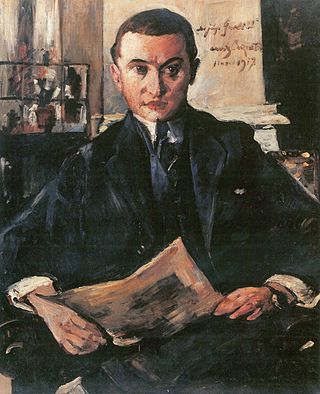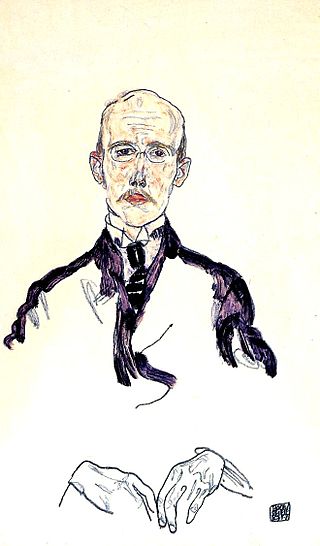Related Research Articles

Egon Leo Adolf Ludwig Schiele was an Austrian Expressionist painter. His work is noted for its intensity and its raw sexuality, and for the many self-portraits the artist produced, including nude self-portraits. The twisted body shapes and the expressive line that characterize Schiele's paintings and drawings mark the artist as an early exponent of Expressionism. Gustav Klimt, a figurative painter of the early 20th century, was a mentor to Schiele.

The Österreichische Galerie Belvedere is a museum housed in the Belvedere palace, in Vienna, Austria.

The Dorotheum is one of the world's oldest auction houses and is the largest auction house of art items in Continental Europe. Established by Emperor Joseph I in 1707, it has its headquarters in Vienna on the Dorotheergasse and branches in other European countries. Besides auctions, the retail sector also plays a major role in Dorotheum's business. In the Dorotheum, works of art, antiques, furniture, and jewellery from various centuries are put up for auction. The building is constructed in the neo-classical style. It is an attraction for Viennese natives and numerous tourists alike.

The Leopold Museum, housed in the Museumsquartier in Vienna, Austria, is home to one of the largest collections of modern Austrian art, featuring artists such as Egon Schiele, Gustav Klimt, Oskar Kokoschka, and Richard Gerstl.

The Lentos Art Museum is a museum of modern art in Linz, Austria, which opened in May 2003 as the successor to the Neue Galerie der Stadt Linz.

Wolfgang Gurlitt was a German art dealer, museum director and publisher whose art collection included Nazi-looted art.

Portrait of Wally is a 1912 oil painting by Austrian painter Egon Schiele of Walburga "Wally" Neuzil, a woman whom he met in 1911 when he was 21 and she was 17. She became his lover and model for several years, depicted in a number of Schiele's most striking paintings. The painting was obtained by Rudolf Leopold in 1954 and became part of the collection of the Leopold Museum when it was established by the Austrian government, purchasing 5,000 pieces that Leopold had owned. Near the end of a 1997–1998 exhibit of Schiele's work at the Museum of Modern Art in New York, the painting's ownership (provenance) history was revealed in an article published in The New York Times. After the publication, the heirs of Lea Bondi Jaray, to whom the work had belonged before World War II, contacted the New York County District Attorney who issued a subpoena forbidding its return to Austria. The work was tied up in litigation for years by Bondi's heirs, who claimed that the painting was Nazi plunder and should have been returned to them.

Serena (Szeréna) Pulitzer Lederer was an Austro-Hungarian art collector and the spouse of the industrial magnate August Lederer, close friend of Gustav Klimt and instrumental in the constitution of the collection of Klimt's art pieces.

Karl Mayländer was an Austrian art collector and businessman who was deported in 1941 from Vienna to Łódź, in German-occupied Poland, by the Nazis and later murdered in the Shoah.

Dämmernde Stadt is an oil painting by Egon Schiele, a townscape of Krumau, completed in 1913. It also known as Die kleine Stadt II. It was owned until 1930 by Elsa Koditschek, a Jew who survived the Holocaust hidden in Vienna. The painting was taken from her during the Nazi regime. It was auctioned in 1950 at the Dorotheum in Vienna, and bought by a private collector. In 2018, it was auctioned in New York in an act of voluntary restitution, and the proceeds were shared by the descendants of both owners.
The auction house im Kinsky is an important art auction house located in Vienna's Palais Kinsky. The auctioneer of the house is Michael Kovacek.
The Vugesta for “Vermögens-Umzugsgut von der Gestapo" was a Nazi looting organization in Vienna that from 1940 to 1945 seized the possessions of 5,000-6,000 Viennese Jews. It was a key player in the aryanization of Jewish property, redistributing private property stolen from Jewish Austrians to non-Jewish or Aryan Austrians during the Nazi reign in Austria.

Dead City III is an oil on wood expressionist painting by Egon Schiele from 1911. It was owned by the Viennese cabaret artist Fritz Grünbaum before he was murdered by Nazis and has been the object of high-profile disputes and court battles. Suspected by New York's District Attorney of having been looted by the Nazis, Dead City III was temporarily confiscated from the Austrian art collector Rudolf Leopold after he loaned it to a New York museum in 1998. The ownership history of the painting has been the object of high-profile court cases in which two very different versions of the painting's journey from the Jewish Holocaust victim to the Austrian art collector collide.
Serge Sabarsky was an art collector and art dealer of the 20th century.
Heinrich Rieger was an Austrian dentist whose art collection was one of the most important in Austrian modern art. Rieger and his wife were murdered in the Holocaust.
Oscar Reichel was an Austrian physician and art collector. His work was confiscated by the Nazis during World War II, leading to claims from his descendants to restore it to them.
Franz Kieslinger was an Austrian art historian and art dealer, who was a Nazi and involved in art theft during the Nazi era.
Friedrich Maximilian Welz was an Austrian art dealer and Nazi Party member investigated for art looting.

Jenny Steiner was an Austro-Hungarian art collector, patron of the arts and factory owner expropriated under the Nazis.
References
- ↑ Lillie, Sophie 1970- (2003). Was einmal war Handbuch der enteigneten Kunstsammlungen Wiens. Czernin. ISBN 978-3-7076-0049-0. OCLC 231981591.
{{cite book}}: CS1 maint: numeric names: authors list (link) - ↑ "A portrait, person by person, item by item, of a society wiped out". The Art Newspaper - International art news and events. 2004-07-01. Retrieved 2021-10-17.
- ↑ "A chest of drawers, designed by Oskar Strnad before 1914, - Design 2017/11/02 - Estimate: EUR 3,000 to EUR 5,000 - Dorotheum". www.dorotheum.com. Archived from the original on 2021-10-17. Retrieved 2021-10-17.
- ↑ "10 Viennese Modernism gems for art fans". A Luxury Travel Blog. 2018-02-02. Archived from the original on 2021-10-18. Retrieved 2021-10-18.
Apart from co-founding the Vienna Workshop, Austrian artist Koloman Moser was a ground breaking graphic designer, ceramicist, silver, jewellery, fashion and not least furniture designer. This bench and chairs, mirror and display cabinet in lacquered acorn wood were created for the parlour furnishings of the Hellmann family.
- ↑ Artdaily. "Sotheby's to Sell Restituted Masterpiece by Egon Schiele". artdaily.cc. Retrieved 2021-10-17.
- ↑ "EGON SCHIELE | KLEINKIND (BABY)". Sothebys. Archived from the original on 2020-08-12.
- 1 2 Cohan, William D. (2012-09-06). "Charting a New Course". ARTnews.com. Retrieved 2021-10-17.
- ↑ "Cases: Krumau, 1916 or 'Städtchen am Fluß' by Egon Schiele: Restitution decision by the City of Linz December 2002". www.lootedart.com. Retrieved 2021-10-17.
- ↑ "Austrian City to Return Looted Art". www.lootedart.com. The Guardian. Archived from the original on 2010-11-24. Retrieved 2021-10-17.
- ↑ "Painting stolen by Nazis may rise £7m for its owners". www.lootedart.com. The Telegraph. Archived from the original on 2010-11-24. Retrieved 2021-10-17.
- ↑ "Heir to Jewish refugees given US court backing to reclaim masterpiece". www.lootedart.com. The Guardian. Archived from the original on 2010-11-24. Retrieved 2021-10-17.
- ↑ "Vienna museum settles in looted painting case". Reuters. 2012-06-14. Retrieved 2021-10-17.
- ↑ "Lost Art Internet Database - Search". www.lostart.de. Retrieved 2021-10-17.